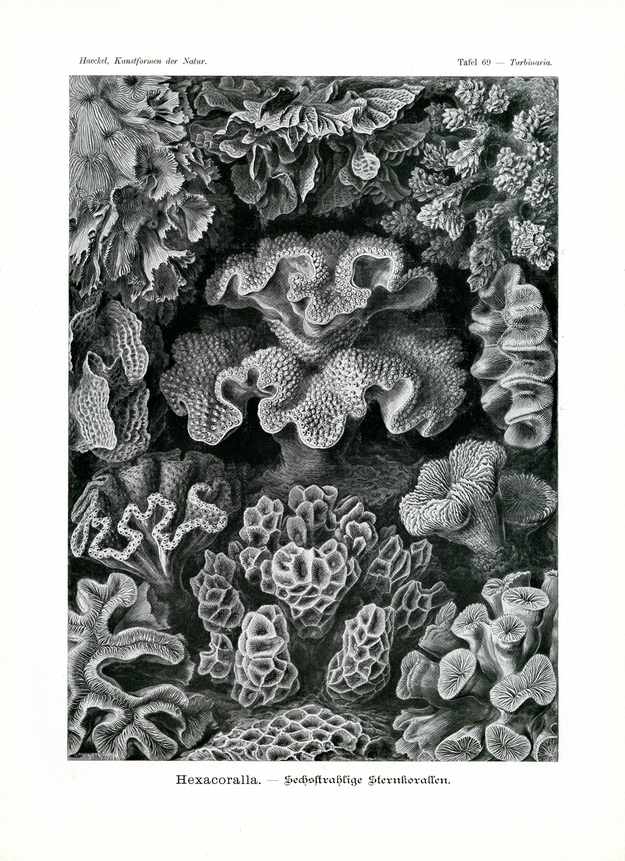Translation of the original German introduction by Ernst Haeckel:
Phylum of Cnidaria (Nesseltiere); - class of Anthozoa (Korallen); - legion of Zoantharia (Sternkorallen); order of Hexacoralla (sechsstrahlige Sternkorallen).
Phylum of Protista; - class of Infusoria; - subclass of Ciliata.
This plate presents a group of coral colonies as they are found on the magnificent Coral reefs of tropical zones in huge variety of shapes and colourfulness. Here only the cleaned lime skeletons of these ‘flower-animals’ are illustrated; the colourful, fleshy coat that covers the lime skeletons of the living animals, presented in the case of Actiniae on plate 49, is removed here. All species illustrated on our plate belong to the order of Hexacoralla (so Anthozoa illustrated on plates 9 and 49); they originate from the Indian coral reefs of Insulinde (Singapore, Java, Sumatra); all species (with exception of fig. 8) form colonies or Corma that are composed of numerous individual polyps or personae; fig. 8 alone presents a couple of individuals that do not form colonies. The six-radial basic shape of Hexacoralla is effected with the help of six pouches that emanate from the top of the central abdomen of the pyramid-shaped individual (at the base of the inverted pyramid); these pouches are separated by thin membranes (Septa); with again and again new membranes developing in between the six original ones a multi-radiant star emerges (compare the explanation given in plates 9 and 49). The numerous individuals that are united in each individual coral colony and come into existence by incomplete, repeated separation (budding or splitting) of an individual, primary persona, live in a perfect communism; all remain connected through branched ‘feeding canals’ that permeate the whole colony and distribute equally the food gathered by individual personae.
The shape of coral colonies is highly manifold and changing depending on the kind of branching and growth as well as on living conditions that keep changing the colonies in multiple ways. At times the convivial individuals of the colony are tightly pressed together forming a compact mass (like Astraea, fig. 9, 10); at times they are joined together only at the base roots (like Euphyllia, fig. 12). The main branches of the colony form thick vine (Hydnophora, fig. 5); at times thin leaves (Lophoseris, fig. 3, 4). Among the many coral species no colony looks like the other (just like trees in a forest of oak wood); the artificial differentiation in “good species” (Bonae Species) appears arbitrary. Fig. 1 and 2 belong to the family of Madreporidae, fig. 3 and 4 to the Fungida, fig. 5-12 to the Astraeida.
Translation by VR Translators Bangalore
We've scanned the original lithography at 1200dpi on the Epson A3 scanner of A3 scanner huren. You can download a 400dpi JPEG here.
